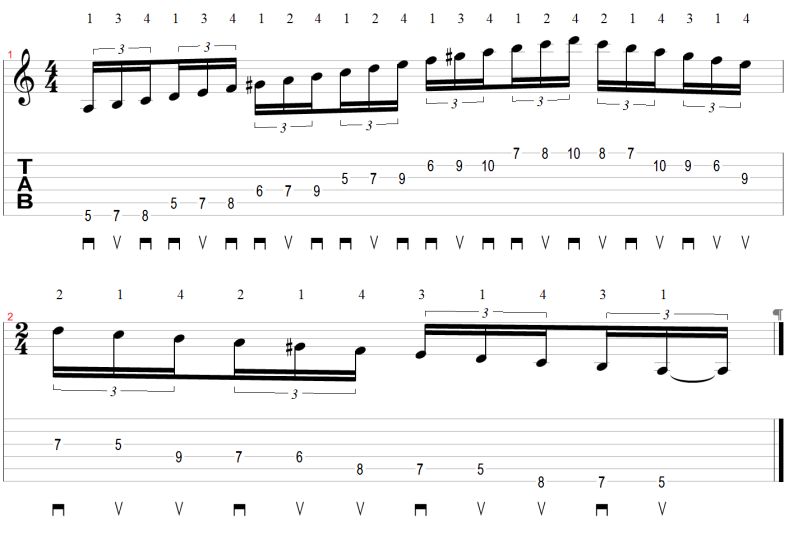How To Become A Great Neoclassical Guitarist - FREE 14 Day Neoclassical Guitar Lessons Mini Course - Part 4

Welcome to part 4 of the mini course on how to become a great neoclassical guitarist! Today I want to tell you about some of the most important components of neoclassical sound and show you several ways how you can start using them to make your guitar playing more creative! We will be talking about the Harmonic minor scale and its very close relative - the Hirajoshi scale. I will also show you how to get started with using these scales creatively in your music. By the end of this lesson you will know more about these two scales and you will see how they can be used to create a unique sound.
We will begin with the Harmonic minor scale. This scale is hugely important for neoclassical guitar playing, and I use it very often in many of my most famous guitar solos. The reason why it is so important for this style is because the music of the composers who influenced the evolution of neoclassical rock genre was largely based on this scale.
If you are not familiar with the Harmonic minor scale, here is the tab of it with the correct picking and fingering:

This scale is shown in the key of A harmonic minor (because it starts on the 5th fret of the low E string which is note A). However, it can be moved up or down the guitar neck and played in any key. For example, if you move the scale up 2 frets, you will now be playing the B harmonic minor scale.
Practice the fingering shown above until you have it totally memorized. This scale has a very cool and dramatic sound which occurs because of two specific notes within the scale. Here is another diagram of the same scale with these important notes circled:

The interval (distance) between the two notes circled in the tab (notes 6 and 7 of the scale) creates a lot of drama and tension which makes neoclassical music so great!
After you learn the basic fingering of the Harmonic minor scale, the next thing you need to work on is learning how to creatively play this scale all over the neck of the guitar. In my Neoclassical Revelation program, I train my students on many different ways of using this scale (as well as other scales used in neoclassical music). I will share with you 2 ideas you can begin working on now.
Using sequences: Most of the time in music, the notes of the scale are not played in a set order. Instead, the notes of the scale are grouped in series of repeating patterns called sequences. Here is one example of a sequence:

Listen to the example
If you listen carefully, you can hear the same basic pattern repeating through the entire sequence. Here is the pattern (it is circled in the notation):

This basic grouping is used to play through the scale as a sequence rather than simply playing one note after the other. Doing this not only helps to extend the scale, but also sounds much more interesting musically when used in guitar solos. Composers such as J.S. Bach, Antonio Vivaldi, and neoclassical guitar masters such as Yngwie Malmsteen use scale sequences (such as this one) all over their music.
There are dozens of different sequences that can be created from a single scale. When used in songs and guitar solos, they will help you to become a much more creative musician!
Playing the scale on one string - whenever scales are played on one string, a new and unique kind of sequence is created. You saw one example of this in lesson 1 of this mini course when I showed you a pedal point example using the harmonic minor scale on a single string. However there are many other ways in which a scale can be played on one string. Look at one example of this below:

A sequence such as this one is very commonly heard in the solos of neoclassical guitar players such as Yngwie Malmsteen.
As you practice playing these scale sequences, I want you to play them in every key (not only in the key of A harmonic minor as shown). Doing this will greatly help you with using these musical ideas creatively in your guitar playing.
Now I want to show you the Hirajoshi scale, which is simply a “5 note (pentatonic) version” of the Harmonic minor scale. The Harmonic minor scale contains 7 notes and a Hirajoshi scale contains only 5 of those notes.
Here is an example. You saw earlier the Harmonic minor scale (in the key of A harmonic minor):

And here is the Hirajoshi scale in the same key. Notice how it has almost the same notes as the Harmonic minor scale above, but it is missing notes 4 and 7.

Because these two scales are very close relatives to one another, they can be mixed together when playing guitar solos and this will give your playing a much more exotic sound!
Here is a short example of how the Harmonic minor scale and the Hirajoshi scale can be combined together:

Hirajoshi and harmonic minor example
You can also apply the same sequencing techniques to the Hirajoshi scale that I showed you for the Harmonic minor scale.
In my Neoclassical Revelation course, I focus a lot on this area of guitar playing and I teach my students not only all of the essential scales used in neoclassical music, but also dozens of creative approaches to using them in order to create great sounding neoclassical music.
Any ordinary person can learn to become a great neoclassical guitar player with the right training. I enjoy teaching guitar players like you every day. If you are ready to become one of them then visit my website to begin now!
Go here to review Lesson 1 of this mini course.
Go here to review Lesson 2.
Review Lesson 3 here.
